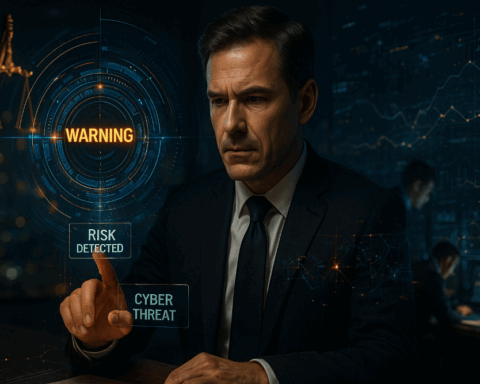Cybercrime and data breaches have evolved into one of the most disruptive and strategically significant threats within the modern corporate landscape. In an era where digital processes form the backbone of virtually every organization, the speed, scale and sophistication of cyberattacks create a risk dynamic that continuously outpaces traditional security measures. Cybercriminals operate in highly organized structures, employing advanced attack techniques such as ransomware, supply-chain compromises, social engineering and automated attack tools. Their objectives extend beyond financial gain to include the disruption of business continuity and the acquisition of strategically sensitive information. The legal, operational and reputational risks arising from a data breach are substantial; regulators are increasingly assertive, remediation costs can escalate rapidly and reputational damage may have lasting consequences for the trust of customers, shareholders and business partners. Boards face the complex task of not only responding to immediate threats but also constructing a sustainable framework of governance, compliance and risk management capable of withstanding rapid technological and regulatory developments.
Against this backdrop, compliance with increasingly stringent legal frameworks has become a strategic imperative, with the General Data Protection Regulation (GDPR) forming the foundation for obligations relating to data security and incident notification. Regulation is characterized by a growing emphasis on detail, accountability and supervisory oversight, requiring organizations to position themselves adequately both technically and organizationally. This includes the systematic implementation of cybersecurity policies, ongoing risk assessments, internal control structures, incident response mechanisms and periodic training that embeds risk awareness throughout the corporate culture. Cybersecurity is no longer an isolated IT issue but a fully integrated strategic concern intertwined with corporate governance, supply-chain management and corporate legal responsibilities. For boards, proactive engagement with external experts, industry bodies and regulators is essential to identify and mitigate emerging threats in a timely manner. Only through a holistic, legally grounded and future-proof approach can an organization safeguard its continuity and maintain the trust of its stakeholders.
Types of Cybercrime
Cybercrime encompasses a vast diversity of methods and tactics, each with its own characteristics, complexity, and impact. Ransomware is currently perhaps the most hyped form of cyberattack; it involves malicious software that hijacks systems and data by encrypting them, after which ransom is demanded to restore access. The devastating effect of ransomware has led to millions in losses and reputational damage across many sectors. Phishing is another common tactic based on deceiving victims through fraudulent emails or messages, tricking them into revealing sensitive information or access credentials. This form of social engineering cleverly exploits human weaknesses such as trust and inattentiveness, blurring the line between technology and psychology. Hacking, unauthorized access to computer systems, can range from simple exploits to complex intrusions by organized criminal networks or even state actors. Distributed Denial of Service (DDoS) attacks make systems temporarily unusable by overwhelming them with traffic, causing financial damage and loss of reputation. Malware, in a broader sense, includes all kinds of malicious software such as spyware, trojans, and worms that steal data, sabotage systems, or infiltrate networks. The increasing sophistication of social engineering techniques underlines that cybercrime is not merely a technical phenomenon but also a psychological battleground where deception is central.
These different forms of cybercrime are often interwoven in complex attacks, requiring a multidimensional approach to combat them. For example, a phishing attack may serve as an entry point for a ransomware infection, after which hackers use a DDoS attack to distract attention from the actual breach. Criminals continuously adapt and develop new techniques that constantly challenge organizational defenses. The diversity of means and objectives also demands a differentiated approach to security and response. Legally, this means that definitions and sanctions for cybercrime must be continuously evaluated and adapted to adequately respond to evolving threats. Moreover, legislators and regulators must strike a balance between security, privacy, and innovation in the digital space. The awareness is growing that the fight against cybercrime is not a matter of one-time interventions but of permanent vigilance and cooperation among various actors, both nationally and internationally.
Data Breaches and Privacy
Data breaches fundamentally threaten the protection of personal data and sensitive corporate information, directly impacting individuals’ privacy rights and the confidentiality of business data. Unauthorized access to data can stem from technical vulnerabilities, such as insufficiently secured systems, but also from human error or malicious insiders. The loss or theft of personal data can lead to identity fraud, financial abuse, discrimination, and even physical threats. Companies and organizations victimized by a data breach suffer not only operational and financial damage but also significant loss of trust from customers, partners, and the public. It is becoming increasingly clear that data protection is not merely a technical issue but also one of governance, culture, and strict regulatory compliance.
The European General Data Protection Regulation (GDPR) imposes high demands on organizations regarding the processing and security of personal data. Under this legislation, data breaches must be reported within 72 hours to the competent authority, unless it is unlikely that the breach poses a risk to the rights and freedoms of data subjects. Organizations must also demonstrate that they have taken appropriate technical and organizational measures to prevent breaches, such as encryption, access control, and regular audits. Privacy-by-design and privacy-by-default have become essential principles within IT system architecture. Compliance with these obligations requires a deep integration of privacy and security into all business processes, demanding significant organizational and legal effort. In case of a breach, careful and transparent incident management is essential to mitigate impact and prevent further legal consequences.
Besides legal requirements, there is growing awareness that data breaches also carry ethical dimensions. Organizations should respect the privacy of individuals as a fundamental right and not merely as a legal obligation. The trust that consumers and business partners place in an organization’s ability to safeguard their data is crucial for reputation and continuity. Complex sectors such as financial services and healthcare face particular challenges due to the nature and sensitivity of the processed data. Risk management must therefore consider not only technical aspects but also legal liability, compliance, and societal expectations regarding transparency and accountability.
Legislation and Regulation
The legal framework surrounding cybercrime and data breaches has undergone profound changes and tightening in recent years, particularly within the European Union, where regulations such as the General Data Protection Regulation (GDPR) have set the standard for personal data protection. This legislation not only obliges organizations to implement adequate security measures but also introduces a breach notification requirement and imposes heavy penalties for non-compliance. The nature of this regulation is both preventive and repressive: preventive because it forces organizations to structure their processes and systems based on strict security and privacy principles; repressive because violations can lead to substantial fines and reputational damage. Besides the GDPR, there are various national cyber laws imposing additional requirements, for example concerning digital infrastructure, critical sectors, and criminal prosecution of cybercriminals.
The data breach notification requirement is one of the most characteristic elements of the European regulatory framework. Organizations must report an incident to the supervisory authority within 72 hours and, if the risk is high, also to the data subjects concerned. This obligation aims not only to ensure transparency but also to encourage a culture of responsibility and timely incident response. The regulation requires careful risk and impact assessment as well as a robust internal organization to comply with the notification duty. Legally, the burden of proof to demonstrate that adequate security measures were taken in the event of incidents is essential to avoid fines. This demands documented policies, protocols, and integration of privacy and security measures into business operations.
Besides the GDPR and national laws, organizations face a tangle of sectoral rules, international agreements, and standards frameworks such as ISO 27001. Compliance with laws and regulations thus remains a challenging but unavoidable task. Legal developments also show increasing attention to international cooperation in combating cybercrime. Sanctions, criminal prosecution, and cross-border investigations require alignment between countries and agencies. Legal experts play a crucial role in translating this complex legislation into practical guidelines and guiding organizations in compliance and incident processes. Ultimately, it is about finding a balance between security, privacy, and innovation, with legislation serving as the foundation for trust and legal certainty in the digital society.
Security Measures
Protection against cybercrime and data breaches heavily relies on the effectiveness of technical and organizational security measures. Firewalls serve as a first line of defense by monitoring and filtering incoming and outgoing network traffic based on preset rules. This prevents unwanted or malicious data from accessing internal systems. Encryption plays an indispensable role in securing data during storage and transmission by encoding sensitive information so that only authorized parties can decrypt it. Endpoint security focuses on protecting individual devices such as laptops, smartphones, and servers, which often constitute the most vulnerable point within a network. Multi-factor authentication (MFA) adds an additional security layer by requiring multiple forms of verification, significantly reducing the risk of unauthorized access.
These measures must be an integral part of a broad, layered security strategy, where technology, policy, and human behavior intersect. Technical solutions alone offer no guarantee without well-formulated protocols, regular updates, and continuous monitoring. Securing digital environments requires a holistic approach, where not only prevention but also detection and response are central. Security measures must also be scalable and adaptive, given the continuous evolution of threats and the emergence of new technologies such as cloud computing and the Internet of Things (IoT). Organizations must invest in robust infrastructures while remaining alert to the latest developments and vulnerabilities.
Implementing these security measures is legally not merely a technical responsibility but a statutory obligation under the GDPR and other regulations. In the event of a data breach, the absence or inadequacy of security can lead to severe penalties and liability. This implies careful documentation of measures taken, risk assessments, and incident reporting. Legal expertise is essential to translate technical measures into compliance requirements and to provide adequate accountability to supervisors and data subjects. It is also important that these measures are continuously evaluated and adapted to keep up with both technical and legal standards.
Incident Detection and Response
Timely discovery of cyberattacks and data breaches is crucial to limit damage as much as possible. Incident detection involves the use of advanced monitoring tools that continuously analyze network traffic and system activity to flag suspicious patterns or anomalies. Real-time data analysis enables early identification of potential threats, making it possible to act immediately before attackers gain deeper access or exfiltrate data. Deployment of Security Information and Event Management (SIEM) systems and Intrusion Detection Systems (IDS) is a cornerstone of this capability. These technologies collect and correlate data from multiple sources, producing an integrated view of security posture and enabling faster detection of attacks.
Beyond technical detection, forensic investigation plays an indispensable role after an incident. Such investigations focus on determining the nature, scope and root cause of the attack, and on identifying the actors involved and the techniques employed. Careful analysis of digital traces not only maps damage but also reveals indicators of future vulnerabilities. Forensic work therefore provides evidence relevant to legal proceedings and delivers concrete input for improving security controls and tightening incident response protocols. The combination of detection and in-depth investigation is essential not only to manage the immediate incident effectively but also to strengthen long-term resilience.
Response to a cyber incident requires a well-crafted and rapidly executable procedure. Establishing an Incident Response Team (IRT) that brings together legal, technical and communications specialists is vital. An effective response plan defines clear roles, communication lines and escalation protocols so that decisions can be made quickly and decisively. Legal departments play a key role in assessing notification obligations, managing liability and ensuring regulatory compliance. At the same time, attention must be paid to communication with stakeholders, customers and supervisory authorities to limit reputational harm. Speed and quality of incident response often determine the difference between manageable consequences and prolonged crises.
Risk Management and Assessment
The foundation of a robust cybersecurity strategy lies in a thorough risk management process. This begins with systematic identification and classification of vulnerabilities across IT infrastructure, business processes and human behaviour. Not all risks are equal in nature or impact; a differentiated risk analysis is therefore necessary, assessing the likelihood of an incident and its potential consequences. Prioritisation allows resources and attention to be allocated where they deliver the greatest reduction of risk, which is essential given rising complexity and finite security budgets. Adoption of internationally recognised standards and frameworks such as ISO 27001, NIST or COBIT supports structuring of risk management and fosters a culture of continuous improvement.
Risk assessment is not static; it requires continual review and updating. The dynamics of cyber threats mean new vulnerabilities can emerge rapidly, while changes in business processes and IT architecture may introduce fresh risks. Periodic audits and penetration testing are indispensable to evaluate effectiveness of existing controls and to optimise them. Risk management must also account for external factors such as new legislation, technological developments and geopolitical tensions that shape the threat landscape. In this context, senior management and governance have a pivotal role; embedding risk management into strategic decision-making is indispensable for building resilient organisations.
The risk management process must also address the human factor, which frequently constitutes the weakest link in cybersecurity. This entails not only training and awareness but also embedding technical and organisational controls to reduce the impact of human error and malicious insiders. An integrated approach is required in which cybersecurity is not isolated from other risk domains but incorporated into enterprise risk management. Such alignment produces coherent policy that strengthens technical security while making legal and organisational risks more manageable.
Awareness and Training
People represent an undeniably critical link in securing digital environments. Despite advanced technical protections, employee behaviour and knowledge often remain the greatest vulnerability within organisations. Cybercriminals exploit this via social engineering and phishing campaigns that deliberately tap into human psychological drivers such as trust, curiosity and time pressure. Raising awareness of cyber threats is therefore an essential element of any security strategy. That begins with cultivating a culture that takes security seriously and encourages staff to report suspicious activity without fear of negative repercussions.
Training and education should be delivered systematically and continuously, tailored to different roles and levels within an organisation. Offerings can range from broad awareness campaigns to in-depth workshops for IT personnel and management. Effective programmes combine theoretical knowledge with practical exercises—phishing simulations, tabletop exercises and technical drills—to sharpen staff vigilance and increase organisational resilience. Measuring programme outcomes and adapting content to emerging threats and technological change maximises impact. Investment in human capital of this kind ultimately translates into a substantial reduction in the likelihood of successful cyberattacks and data breaches.
From a legal perspective, training is also important evidence of compliance with laws and regulations. Organisations can demonstrate that obligations regarding awareness and security are taken seriously, which may influence liability assessments after incidents. Documentation of training activities and their evaluation is therefore an indispensable element of a compliance programme. In addition, staff training not only strengthens internal security but also bolsters the confidence of customers and regulators. In an era where reputation and transparency matter greatly, awareness and training have become strategic instruments for achieving digital resilience.
Collaboration and Information Sharing
The fight against cybercrime and the prevention of data breaches cannot be won in isolation. Collaboration between various parties within the business sector, government agencies, and specialized institutions is essential for effective cyber resilience. By sharing threat information, best practices, and lessons learned, organizations can respond more quickly to new attack methods and vulnerabilities. In the Netherlands and the European Union, Computer Emergency Response Teams (CERTs) play a crucial role in this information exchange, acting as a central point for collecting, analyzing, and distributing cyber threat intelligence.
Promoting collaboration requires building trust among different stakeholders and establishing secure and structured communication channels. This also involves sharing sensitive information about incidents and vulnerabilities, which carries legal and reputational risks. Therefore, clear agreements and frameworks are necessary to protect interests and respect privacy. Public-private partnerships are increasingly important in this context, with governments and businesses working together to strengthen national and regional cybersecurity infrastructure and capabilities.
The added value of collaboration also extends to the international context. Cybercrime knows no borders, making cross-border cooperation and regulatory harmonization vital. Participation in international forums and initiatives enhances the ability to act in a coordinated manner against cyber threats and to mitigate their consequences. This demands a joint effort of legal, technical, and policy resources and a clear division of roles among the involved actors.
Legal Consequences and Sanctions
The legal implications of cybercrime and data breaches are extensive and can have far-reaching consequences for organizations and individuals. In the Netherlands and within the European Union, a strict legal framework applies in which the protection of personal data and the security of digital systems are central. The General Data Protection Regulation (GDPR) imposes obligations on organizations regarding the processing of personal data, including the duty to report data breaches to the supervisory authority and affected individuals within 72 hours. Failure to comply with these rules can result in hefty fines, which can amount to up to 20 million euros or 4% of the global annual turnover, in addition to civil claims from those affected.
Moreover, organizations may face criminal prosecution when failures in security measures or negligence lead to serious harm. The Criminal Code contains provisions against hacking, deliberately causing damage to information systems, and violating confidentiality. Legal proceedings in this context are often complex and require in-depth knowledge of both IT and criminal law procedures. Criminal prosecution can result not only in financial penalties but also in prison sentences for responsible individuals within an organization.
The consequences of cyber incidents are not limited to fines and criminal sanctions; reputational damage can be equally devastating. Loss of trust among customers, investors, and partners can lead to revenue loss and lasting image damage. From a legal perspective, reputational harm may give rise to compensation claims, especially since privacy law increasingly enables affected parties to enforce their rights. Organizations must therefore act not only reactively in the event of incidents but also proactively invest in compliance, governance, and crisis management to minimize legal and reputational risks and ensure business continuity.










